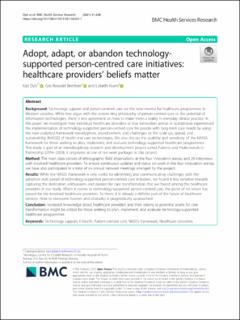| dc.description.abstract | Background Technology support and person-centred care are the new mantra for healthcare programmes in Western societies. While few argue with the overarching philosophy of person-centred care or the potential of information technologies, there is less agreement on how to make them a reality in everyday clinical practice. In this paper, we investigate how individual healthcare providers at four innovation arenas in Scandinavia experienced the implementation of technology-supported person-centred care for people with long-term care needs by using the new analytical framework nonadoption, abandonment, and challenges to the scale-up, spread, and sustainability (NASSS) of health and care technologies. We also discuss the usability and sensitivity of the NASSS framework for those seeking to plan, implement, and evaluate technology-supported healthcare programmes. This study is part of an interdisciplinary research and development project called Patients and Professionals in Partnership (2016–2020). It originates at one of ten work packages in this project. Method The main data consist of ethnographic field observations at the four innovation arenas and 29 interviews with involved healthcare providers. To ensure continuous updates and status on work in the four innovation arenas, we have also participated in a total of six annual network meetings arranged by the project. Results While the NASSS framework is very useful for identifying and communicating challenges with the adoption and spread of technology-supported person-centred care initiatives, we found it less sensitive towards capturing the dedication, enthusiasm, and passion for care transformation that we found among the healthcare providers in our study. When it comes to technology-supported person-centred care, the point of no return has passed for the involved healthcare providers. To them, it is already a definite part of the future of healthcare services. How to overcome barriers and obstacles is pragmatically approached. Conclusion Increased knowledge about healthcare providers and their visions as potential assets for care transformation might be critical for those seeking to plan, implement, and evaluate technology-supported healthcare programmes. | en_US |

